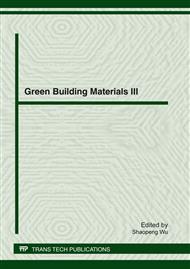[1]
P.B. Koeneman, I.J. BuschVishniac, K.L. Wood, Feasibility of micro power supplies for MEMS, J. Microelectromech. Syst. 6 (1997) 355-362.
DOI: 10.1109/84.650133
Google Scholar
[2]
J.N. Harb, R.M. LaFollette, R.H. Selfridge, L.L. Howelld, Microbatteries for self-sustained hybrid micropower supplies, J. Power Sources 104 (2002) 46-51.
DOI: 10.1016/s0378-7753(01)00904-1
Google Scholar
[3]
F. Albano, M.D. Chung, D. Blaauw, D.M. Sylvester, K.D. Wise, A.M. Sastry, Design of a Power Supply for an Intraocular Sensor, J. Power Sources 170 (2007) 216-224.
DOI: 10.1016/j.jpowsour.2007.04.007
Google Scholar
[4]
P. Knauth, Inorganic solid Li ion conductors: An overview, Solid State Ionics 180 (2009) 911-916.
DOI: 10.1016/j.ssi.2009.03.022
Google Scholar
[5]
H.P. Chen, H.Z. Tao, X.J. Zhao, Q.D. Wu, Fabrication and Ionic Conductivity of Amorphous Li-Al-Ti-P-O Thin Film, Journal of Non-Crystalline Solids 357 (2011) 3267-3271.
DOI: 10.1016/j.jnoncrysol.2011.05.023
Google Scholar
[6]
Y.L. Xiong, H.Z. Tao, J. Zhao, H. Cheng, X.J. Zhao, Effects of Annealing Temperature on Structure and Opt-electric Properties of Ion-conducting LLTO Thin Films Prepared by RF Magnetron Sputtering, Journal of Alloys and Compounds 509 (2010).
DOI: 10.1016/j.jallcom.2010.10.086
Google Scholar
[7]
J.L. Narváez-Semanate, A.C.M. Rodrigues, Microstructure and ionic conductivity of Li1+xAlxTi2-x(PO4)3 NASICON glass-ceramics, Solid State Ionics 181 (2010) 1197-1204.
DOI: 10.1016/j.ssi.2010.05.010
Google Scholar
[8]
P. Johnson, N. Sammes, N. Imanishi, Y. Takeda, O. Yamamoto, Effect of microstructure on the conductivity of a NASICON-type lithium ion conductor, Solid State Ionics 192 (2010) 326-329.
DOI: 10.1016/j.ssi.2010.01.005
Google Scholar
[9]
Z.Y. Wen, X.X. Xu, J.X. Li, Preparation, microstructure and electrical properties of Li1. 4Al0. 4Ti1. 6(PO4)3 nanoceramics, J. Electroceram. 22 (2009) 342-345.
DOI: 10.1007/s10832-008-9420-7
Google Scholar
[10]
G. Adachi, N. Imanaka, H. Aono, Fast Li+ Conducting Ceramic Electrolytes, Adv. Mater. 8 (1996) 127-135.
DOI: 10.1002/adma.19960080205
Google Scholar
[11]
L.O. Hagman, P. Kierkegaard, The Crystal Structure of NaM2(PO4)3; M=Ge, Ti, Zr, Acta Chem. Scand. 22 (1968) 1822-1832.
DOI: 10.3891/acta.chem.scand.22-1822
Google Scholar
[12]
K. Takada, K. Fujimoto, T. Inada, A. Kajiyama, M. Kouguchi, S. Kondo, M. Watanabe, Sol-gel preparation of Li+ ion conductive thin film, Appl. Surf. Sci. 189 (2002) 300-306.
DOI: 10.1016/s0169-4332(01)01007-8
Google Scholar
[13]
K. Takada, R. Ma, M. Osada, N. Ohta, L. Zhang, T. Sasaki, Formation of nano-sized particles of a solid electrolyte by laser ablation, Journal of Power Sources 146 (2005) 703-706.
DOI: 10.1016/j.jpowsour.2005.03.061
Google Scholar
[14]
J. Fu, Superionic conductivity of glass-ceramics in the system Li2O-Al2O3-TiO2-P2O5, Solid State Ionics 96 (1997) 195-200.
DOI: 10.1016/s0167-2738(97)00018-0
Google Scholar
[15]
X.X. Xu, Z.Y. Wen, Glass and Glass-ceramics Solid Electrolytes for Lithium-ion Battery, Journal of Inorganic Materials 20 (2005) 21-26.
Google Scholar
[16]
J.S. Thokchom, B. Kumar, Microstructural effects on the superionic conductivity of a lithiated glass-ceramic, Solid State Ionics 177 (2006) 727-732.
DOI: 10.1016/j.ssi.2006.01.027
Google Scholar
[17]
K. Funke, R.D. Banhatti, S. Brückner, C. Cramer, C. Krieger, A. Mandanici, C. Martini, I. Ross, Ionic motion in materials with disordered structures: conductivity spectra and the concept of mismatch and relaxation, Phys. Chem. Chem. Phys. 4 (2002).
DOI: 10.1039/b200122p
Google Scholar
[18]
K. Funke, Jump relaxation in solid electrolytes, Prog. Solid St. Chem. 22 (1993) 111-195.
Google Scholar
[19]
B. Kumar, S. Nellutla, J.S. Thokchom, C. Chen, Ionic conduction through heterogen blocking and space charge effects, J. Power Sources 160 (2006) 1329-1335.
DOI: 10.1016/j.jpowsour.2006.02.062
Google Scholar


